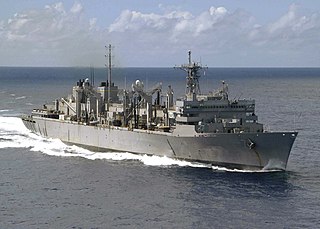
The fast combat support ship is a type of replenishment auxiliary ship. Different from traditional logistic ships, the fast combat support ship is designed with high speed to keep up with the carrier battle group/carrier strike group, while the multi-product station is capable of supplying all types of necessities for the fleet.

A naval ship is a military ship used by a navy. Naval ships are differentiated from civilian ships by construction and purpose. Generally, naval ships are damage resilient and armed with weapon systems, though armament on troop transports is light or non-existent.

The Arleigh Burke class of guided-missile destroyers (DDGs) is a United States Navy class of destroyer centered around the Aegis Combat System and the SPY-1D multi-function passive electronically scanned array radar. The class is named for Admiral Arleigh Burke, an American destroyer officer in World War II and later Chief of Naval Operations. With an overall length of 505 to 509.5 feet, displacement ranging from 8,300 to 9,700 tons, and weaponry including over 90 missiles, the Arleigh Burke-class destroyers are larger and more heavily armed than many previous classes of guided-missile cruisers.
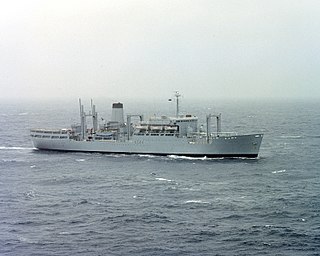
RFA Stromness (A344) was a fleet stores ship which served the Royal Fleet Auxiliary until sold to the U.S. Navy's Military Sealift Command in 1983. While in the service of British forces, it saw service in the Falklands War. After the sale to the United States, it was renamed USNS Saturn (T-AFS-10) and acted as a combat stores ship until it was deactivated in 2009; it was able to supply two other ships at once. In 2010, it was sunk in an exercise by the U.S. Carrier Strike Group Two off the coast of North Carolina.

The Military Sealift Command (MSC) is an organization that controls the replenishment and military transport ships of the United States Navy. Military Sealift Command has the responsibility for providing sealift and ocean transportation for all US military services as well as for other government agencies. It first came into existence on 9 July 1949 when the Military Sea Transportation Service (MSTS) became solely responsible for the Department of Defense's ocean transport needs. The MSTS was renamed the Military Sealift Command in 1970.

Landing helicopter assault (LHA) is the United States Navy's hull classification symbol for the general-purpose helicopter-carrying amphibious assault ships of the Tarawa and America classes.

Combat stores ships, or storeships, are ships used to store naval supplies. They are used to deliver supplies such as provisions and fuel to combat ships on extended deployments. The United States Navy operated the Sirius and Mars classes and the Royal Navy operated the Fort Rosalie class and continues to operate one Fort Victoria class ship, having scrapped the other. They carried or carry the fleets's refrigerated stores, dry provisions, technical spares, general stores, fleet freight, mail and replacement personnel or specialists. Storeships should not be confused with fast combat support ships which are high speed auxiliary ships or tenders which provide maintenance support to flotillas.
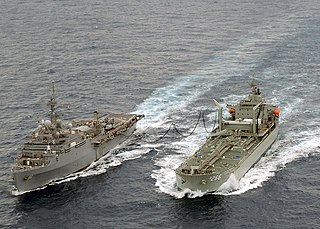
A replenishment oiler or replenishment tanker is a naval auxiliary ship with fuel tanks and dry cargo holds which can supply both fuel and dry stores during underway replenishment (UNREP) at sea. Many countries have used replenishment oilers.

The Henry J. Kaiser class is an American class of eighteen fleet replenishment oilers which began construction in August 1984. The class comprises fifteen oilers which are operated by Military Sealift Command to provide underway replenishment of fuel to United States Navy combat ships and jet fuel for aircraft aboard aircraft carriers at sea.
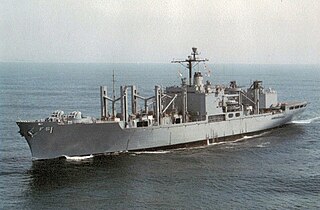
The Mars-class combat stores ships were a class of seven auxiliary vessels of the United States Navy. The ships were designed for underway replenishment, in support of carrier task force groups, carrying miscellaneous stores and munitions. Initially they carried no fuel oil or liquid cargo, but by the early 1990s the class was refitted with limited refuel capacities for F-76 fuel. None of the original seven ships originally commissioned by the US Navy remain in service. The Mars class was replaced by the Lewis and Clark-class dry cargo ships.

USS Sylvania (AFS-2), a Mars-class combat stores ship, was the second ship of the United States Navy to be named Sylvania.

A fast attack craft (FAC) is a small, fast, agile, offensive, often affordable warship armed with anti-ship missiles, gun or torpedoes. FACs are usually operated in close proximity to land as they lack both the seakeeping and all-round defensive capabilities to survive in blue water. The size of the vessel also limits the fuel, stores and water supplies. In size they are usually between 50–800 tonnes and can reach speeds of 25–50 knots (46–93 km/h).

USS White Plains (AFS-4) was a Mars-class combat stores ship in service with the United States Navy from 1968 to 1995. She was sunk as a target in 2002.

The Sacramento-class fast combat support ships were a class of four United States Navy supply ships used to refuel, rearm, and restock ships in the United States Navy in both the Atlantic and Pacific Oceans.

The RIM-66 Standard MR (SM-1MR/SM-2MR) is a medium-range surface-to-air missile (SAM), with a secondary role as an anti-ship missile, developed for the United States Navy (USN). A member of the Standard Missile family of weapons, the SM-1 was developed as a replacement for the RIM-2 Terrier and RIM-24 Tartar that were deployed in the 1950s on a variety of USN ships. The RIM-67 Standard (SM-1ER/SM-2ER) is an extended range version of this missile with a solid rocket booster stage.
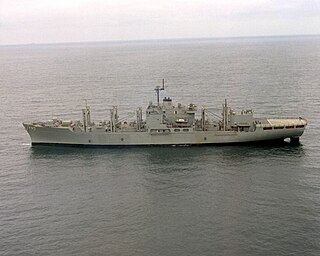
USS San Jose (AFS-7) was a Mars-class combat stores ship acquired by the U.S. Navy (USN) in 1970. She served as a Navy ship until November 1993, and was involved in the Vietnam War and the Persian Gulf War. The ship was transferred to the Military Sealift Command (MSC), and was redesignated USNS San Jose (T-AFS-7). As an MSC vessel, San Jose was involved in the INTERFET peacekeeping taskforce, the response to the December 2004 Indian Ocean tsunami, as well as the wars in Afghanistan and Iraq. The ship was deactivated in 2010, and was sold for scrap in 2013.
ROKS Daecheong (AOE-58) is the second ship of the Cheonji-class fast combat support ship (AOE) in the Republic of Korea Navy. She is named after the lake, Daecheong.

Aircraft repair ship is a naval auxiliary ship designed to provide maintenance support to aircraft. Aircraft repair ships provide similar services to seaplane tenders, that also cared for the crew. Aircraft repair ships had their own stores of spare parts, like a depot ship. Aircraft repair ships had repair personnel and equipment to repair failures or battle damage on aircraft. Aircraft repair ship also did regular aircraft maintenance.
















